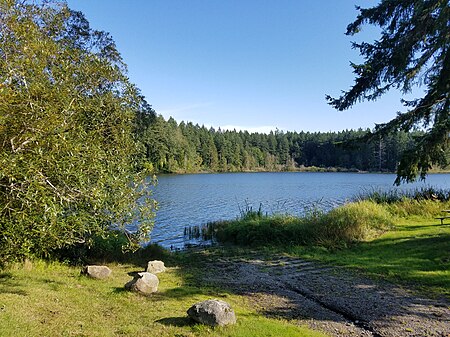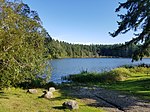Anderson Lake (Jefferson County, Washington)

Anderson Lake is a 57-acre (23 ha) body of water lying 1.5 miles (2.4 km) west of Chimacum in Jefferson County, Washington. It is located in Section 9, Township 29N, Range 1W. Anderson Lake reaches a depth of 29 feet (8.8 m) at its deepest point and has a water volume of 1,228 acre-feet (1,515,000 m3). The lake drains into Chimacum Creek and Port Townsend Bay. It is surrounded by Anderson Lake State Park. The lake's fish population includes lake-reared rainbow trout, that carry over to a second season from the initial spring fishery.Toxic algae has caused the lake to be closed to all access on multiple occasions. The lake has annual cyanobacteria blooms dominated by dolichospermum (anabaena), aphanizomenon and microcystis. It is a major producer of anatoxin-a, a potent neurotoxin. County health officials have monitored local lakes for blue-green algae seasonally since 2007.
Excerpt from the Wikipedia article Anderson Lake (Jefferson County, Washington) (License: CC BY-SA 3.0, Authors, Images).Anderson Lake (Jefferson County, Washington)
Lakeside Trail,
Geographical coordinates (GPS) Address Nearby Places Show on map
Geographical coordinates (GPS)
| Latitude | Longitude |
|---|---|
| N 48.0188527 ° | E -122.8012455 ° |
Address
Lakeside Trail
Lakeside Trail
98325
Washington, United States
Open on Google Maps






